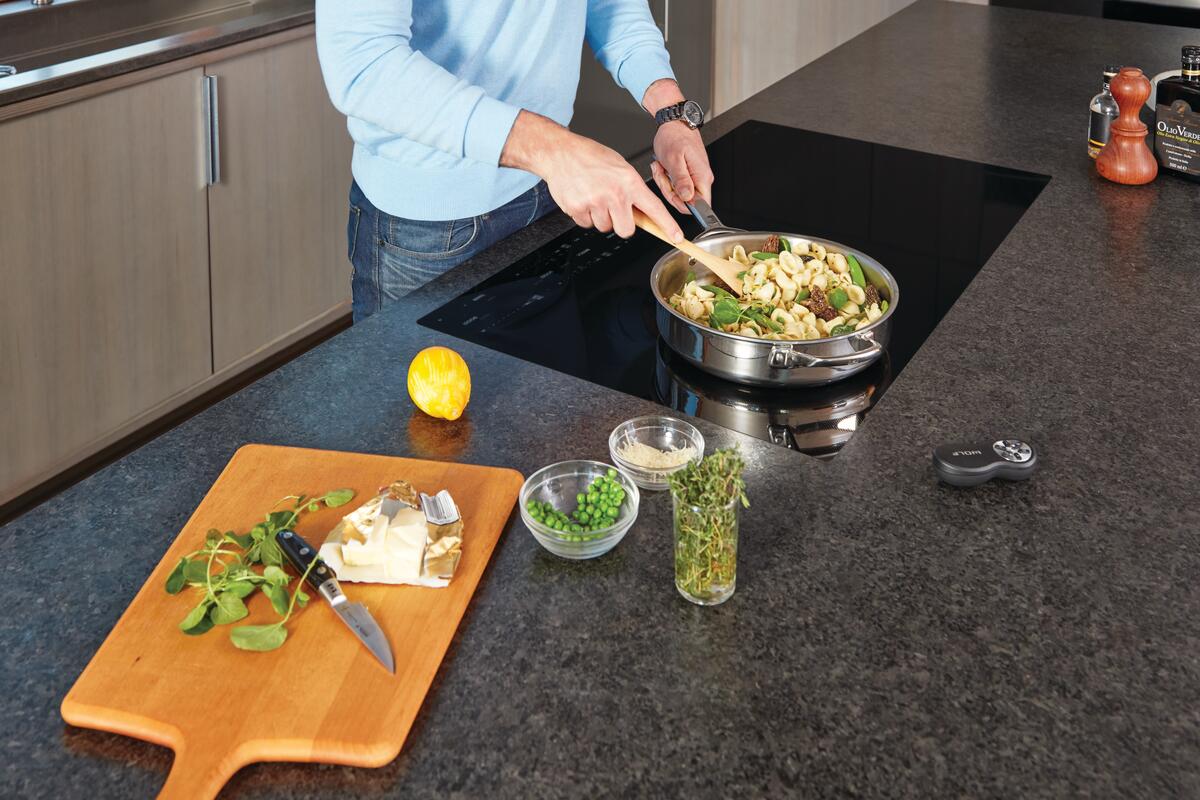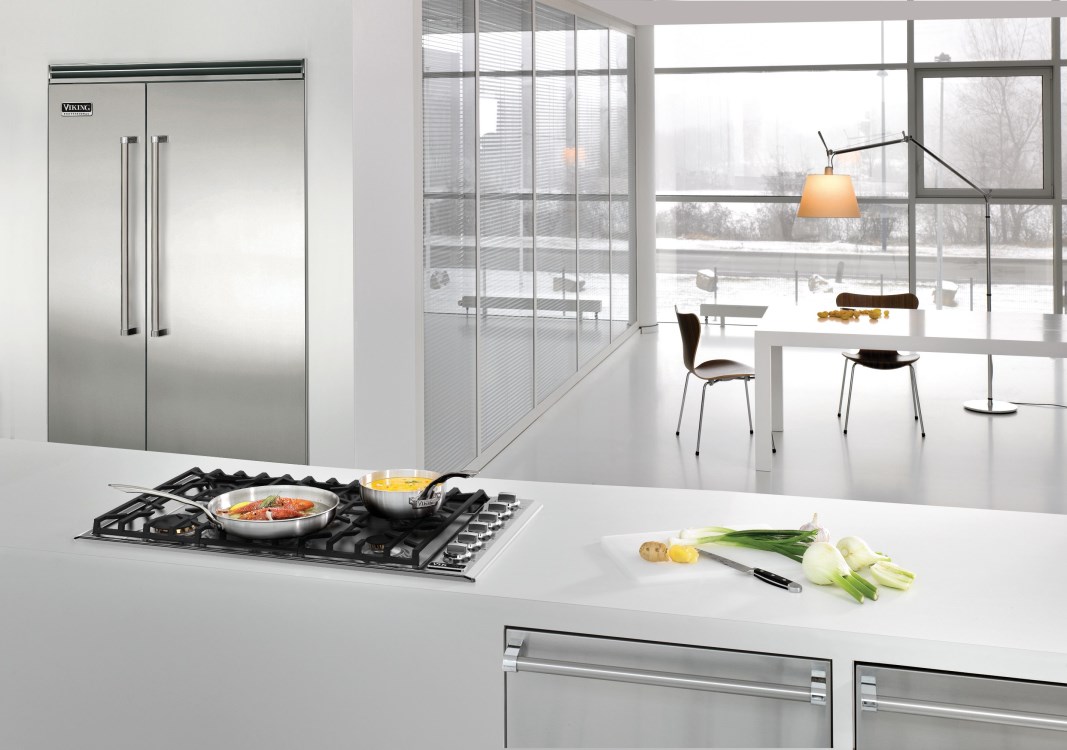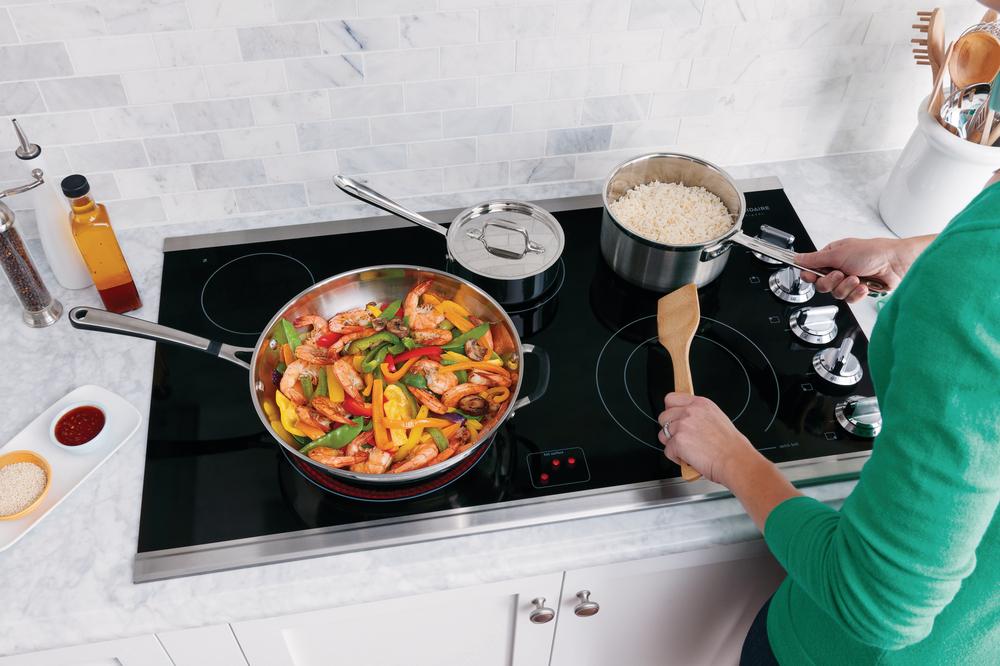If the kitchen is the heart of the home and food is the music of love, then surely, your cooking appliance is the pulse.
Often the focal point of the kitchen, your choice of cooking appliance entails careful consideration. Here, you can exercise some creativity. While a range is considered the tried-and-true option for most residential kitchens, a cooktop offers a layer of customization, as it gifts you the ability to install a built-in oven separately from your cooking elements.
If you’ve ever had the fantasy of flipping pancakes and sizzling bacon in the middle of your kitchen island, this is your golden opportunity. Not ones to have you settle for less, our experts at Aztec Appliance still implore you to dream bigger.
If you’re already in the market for something new, may we interest you in pro-style cooking? We cordially invite you to open the door to pro-style cooking with a restaurant-caliber cooktop—luckily, you can get a taste of the gourmet possibilities with our product guide!
Bon appétit.

Why Buy "Pro-Style"?
Usually left to professional chefs, pro-style cooking with specially engineered appliances imparts many benefits that all passionate home cooks can appreciate. To help distinguish these appliances from standard models, here are a few ways pro cooktops smoke the competition—and sauté and sear it for good measure.
Sizes
First off: pro-style kitchen appliances, including dual-fuel ranges and cooktops, are wider than their standard counterparts. While standard cooktops are typically capped at around 30 inches, pro cooktops can span out further—up to 36 or 45 inches wide—giving you more surface space for cooking so that you can easily manage multiple pots and pans at once.
Durability and Quality
Pro cooktops are built to withstand heavy-handed use. (That said, we wouldn’t recommend banging your cast-iron skillet against your glass cooktop on purpose, either.) These restaurant-grade appliances are meant to turn a home kitchen into a pro-style cooking station without transforming or harming your kitchen design.
Pro-style appliances are durable compared to regular residential cooktops and ranges, which are designed for light cooking. So, if you love to experiment in the kitchen, you’ll need an appliance you can depend on. You won’t have to worry about overuse, and because of its quality, you can expect it to outperform other options. In short, from the materials used to construct it to the way in which it was assembled, a pro-style cooktop will outlast most standard models.
Gas, Electric, and Induction Options
While most standard cooktops on the market offer gas, electric, and induction options, we still think it’s worth unraveling the pros and cons of each fuel type. After all, every seasoned chef is ideally equipped with this knowledge, so here we go.
Favored by professional chefs, gas cooktops allow better control, enabling instant changes in heat while cooking since the flame doesn’t need much time to warm up or cool down. Compared to their electric counterparts, gas cooktops are more durable, and in the long run, more cost-effective. Since gas is generally cheaper than electricity, a pro-style gas cooktop is the most prudent purchase if your family enjoys home-cooked meals every day.
On the other hand, electric cooktops provide a smooth glass surface on which you can flip vegetables, stir sauces, and sprinkle in seasonings with confidence that any spills and sloshes can be wiped away with ease—no vigorous scrubbing required. In addition, electric cooking elements do not generate a lot of ambient heat, unlike gas burners, which usually heat up the kitchen to an uncomfortable degree. With an electric cooktop, you can rest assured your setup stays cool.
And lastly, we have induction cooktops. A sub-type of electric cooktop, induction models transfer heat electromagnetically into compatible cookware with virtually no trace of heat on the induction elements themselves. These appliances are safer to operate since there’s no radiant heat and residual heat dissipates quickly. Plus, due to the technology involved, induction cooking operates more economically, with virtually no heat wasted. In other words, induction is the most energy-efficient option for pro-style cooking.
Price
If a Michelin-starred chef swears by a cooking appliance, it’s safe to assume its price tag is a hefty one. That said, instead of letting short-term costs deter you from making a big investment, think about the long-term benefits a pro cooktop will bring.
Due to their sturdier craftsmanship, intuitive controls, and ultra-convenient features, pro cooktops are built to tackle any job you throw at them, including an ambitious six-course dinner.
In truth, the cost of a pro-style cooktop varies significantly, according to its width and fuel type. In terms of cost by fuel type, it typically goes, gas, electric, and induction when ranked from low to high. It should be noted, however, that some manufacturers may price their gas models higher than their electric cooktops.
For reference, Wolf carries pro cooktops that are priced between $1,985 and $3,000. Monogram offers pro-style cooktops that are valued anywhere from $1,730 to $3,230. And Frigidaire Professional prices theirs between $1,149 and $2,199.

Before You Buy
Before you eagerly scroll through our catalog, there are four important steps we recommend you take. The journey toward pro-style cooking at home starts with the following:
1. Analyze Your Ventilation
Every pro cooking appliance requires pro ventilation. Kitchen hood vents bring peace of mind, as they disperse steam and grease outside of your kitchen in addition to preventing damage to your cabinets. Generally, your kitchen hood vent should be at least as wide as your cooktop and preferably three inches longer on each side.
But pro ventilation doesn’t have to be a snore—you can elevate your kitchen design depending on the style you choose. Professional kitchens typically employ an island range hood that connects to the ceiling to vent out the smoke from above. Or if you prefer a discreet solution, there is downdraft ventilation that hides within your cooktop along with insert range hoods that you can customize to fit with your existing cabinetry.
If you don’t mind making a statement, wall-mounted and under-cabinet range hoods are typically narrow at the top and wider on the bottom. Whereas under-cabinet models are ducted through overhead cabinetry, wall-mounted versions can replace your cabinets altogether so you won’t have to stress about potential damage.
2. Check the Supply Line
While the installation of an electric or induction pro cooktop requires a 240-volt outlet, a gas cooktop requires hookup to a gas line. If you don’t currently have a gas hookup, most manufacturers also offer propane conversion kits for installations where natural gas isn't available.
To test pre-existing gas connections for leaks, we recommend completing the following steps.
First, put a drop of dishwashing soap into a small bowl and add some water. Stir it up with a small, clean brush. Then, when you've got some suds, apply the soapy solution onto every joint in the gas connection line, from the shutoff valve up to the manifold entrance. If at any point the bubbles erupt or show other unusual activity, there’s likely a leak.
In that case, tighten up those joints and repeat the test until you’re certain there are no leaks.
3. Measure the Space
In any appliance shopping endeavor, it is important to take, check, and double-check the height, width, and depth of the available space you hope to fill with your new appliance. In addition to having enough counter space to fit your new pro cooktop, you must ensure there is enough ventilation space on the sides to prevent overheating.
Since minimum clearances for ventilation vary, be sure to read the manufacturer’s recommendations for overhead space, gaps along the sides, and room from the rear wall or cabinet.
When planning your installation of a gas cooktop without a preexisting hookup, provide for a half-inch of rigid gas line with a shutoff valve within three feet of the cooktop location.

Let Us Help You
Our friendly staff at Aztec Appliance is always happy to help you design the kitchen of your dreams. If you have any questions, feel free to call or visit us at our San Diego location. More accessible than ever, our experts are also available via chat!